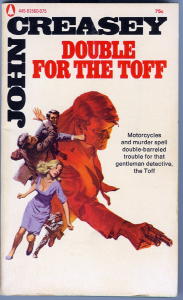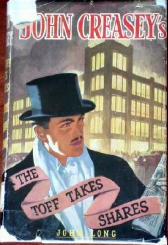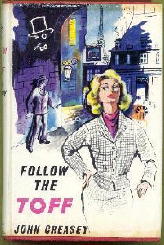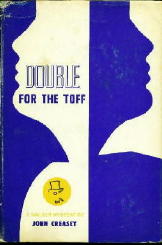Wed 25 Jul 2007
Review: JOHN CREASEY – Double for the Toff.
Posted by Steve under Authors , Characters , Crime Fiction IV , Reviews[3] Comments
JOHN CREASEY – Double for the Toff.
Popular Library, paperback reprint; no date stated, but circa 1972. Hardcover editions: Hodder & Stoughton (UK), 1959. Walker (US), 1965. UK paperback editions: Hodder/Coronet, 1963,1973; Sphere, 1967. Earlier US paperback edition: Pyramid R-1221, Aug 1965.

I’ll make no attempt here to do a general bibliographic discussion of John Creasey and the multitude of mysteries he produced. While that will have to wait for another time, this is certainly the place. As for the Toff, in real life Richard Rollison, I don’t believe it was ever a matter of a secret identity, only an honorific nomenclature.
England seems to have had a long history of gentleman adventurers that did not seem to ever have been as popular in the United States as they were over there. The Toff, like Simon Templar, aka the Saint, before him (adventures recorded by Leslie Charteris), was merely another in a lengthy line of swashbucklers, figuratively speaking.
And again, someone else may be better to write the history of such British adventurers, although again, this is certainly the place. In fact what I know about the Toff is minimal, but of course I will tell you what I know anyway.
Let’s begin with a list of the books. These are in more or less the order in which they appeared in England. A hyphen (-) indicates the lack of an US edition. A star (*) means that there was one. A double star (**) indicates that the first US edition was a paperback. Alternate US titles are also included, if first appearances. (Thanks to Al Hubin’s Crime Fiction IV for most of this information.)
The Toff Goes On. 1939. (-)
The Toff Steps Out. 1939. (-)
Here Comes the Toff. 1940. (*) 1967.
The Toff Breaks In. 1940. (-)
Salute the Toff. 1941. (*) 1971.
The Toff Proceeds. 1941. (*) 1968.
The Toff Goes to Market. 1942. (*) 1967.
The Toff Is Back. 1942. (*) 1974.
The Toff on the Trail. 1942. (-)
Accuse the Toff. 1943. (*) 1975.
The Toff Among the Millions. 1943. (*) 1976.
The Toff and the Curate. 1944. (*) 1969.
The Toff and the Great Illusion. 1944. (*) 1967.
Feathers for the Toff. 1945. (*) 1970.
The Toff and the Lady. 1946. (*) 1975.
Hammer the Toff. 1947. (-)
The Toff on Ice. 1947. (** – Poison for the Toff) 1965.
The Toff and Old Harry. 1948. (*) 1970.
The Toff in Town. 1948. (*) 1977.
The Toff Takes Shares. 1948. (*) 1972.

The Toff on Board. 1949. (*) 1973.
Fool the Toff. 1950. (*) 1966.
Kill the Toff. 1950. (*) 1966.
A Knife for the Toff. 1951. (**) 1964.
The Toff Goes Gay. 1951. (* – A Mask for the Toff) 1966.
Hunt the Toff. 1952. (*) 1969.
Call the Toff. 1953. (*) 1969.
Murder Out of the Past. 1953. (-)
The Toff Down Under. 1953. (*) 1969.
The Toff at Butlin’s. 1954. (*) 1976.
The Toff at the Fair. 1954. (*) 1968.
A Six for the Toff. 1955. (*) 1969.
The Toff and the Deep Blue Sea. 1955. (*) 1967.
Make-Up for the Toff. 1956. (*) 1967.
The Toff in New York. 1956. (**) 1964.
Model for the Toff. 1957. (**) 1965.
The Toff on Fire. 1957. (*) 1966.
The Toff and the Stolen Tresses. 1958. (*) 1965.
The Toff on the Farm. 1958. (*) 1964.
A Doll for the Toff. 1959. (*) 1965.
Double for the Toff. 1959. (*) 1965.
The Toff and the Runaway Bride. 1959. (*) 1964.
A Rocket for the Toff. 1960. (**) 1964.
The Toff and the Kidnapped Child. 1960. (*) 1965.
Follow the Toff. 1961. (*) 1967.

The Toff and the Teds. 1961. (* – The Toff and theToughs) 1968.
Leave It to the Toff. 1963. (**) 1964.
The Toff and the Spider. 1965. (*) 1966.
The Toff in Wax. 1966. (*) 1966.
A Bundle for the Toff. 1967. (*) 1968.
Stars for the Toff. 1968. (*) 1968.
The Toff and the Golden Boy. 1969. (*) 1969.
The Toff and the Fallen Angels. 1970. (*) 1970.
Vote for the Toff. 1971. (*) 1971.
The Toff and the Trip-Trip-Triplets. 1972. (*) 1972.
The Toff and the Terrified Taxman. 1973. (*) 1973.
The Toff and the Sleepy Cowboy. 1974. (*) 1975.
The Toff and the Crooked Copper. 1977. (-)
There was even a three-act play in which the Toff was a leading character: “The Toff.” UK, 1963.
Creasey died in 1973, so the final three books had been written and were still awaiting publication when he passed away. The Toff was popular enough in England that when his publisher (Hodder & Stoughton) ran out of Toff books to sell, they hired William Vivian Butler to write a very last one: The Toff and the Dead Man’s Finger (1978; no US publication).
Besides three books of his own, Butler also wrote the final five Commander George Gideon novels, Gideon being Creasey’s Scotland Yard detective whose adventures he wrote as J. J. Marric.
In creating this list of Toff books, there are several things I discovered that I hadn’t known before. First, I didn’t realize how many of the books were published in the US. If that were the question, the answer would be “almost all of them.” I also didn’t realize that the Toff was introduced to American readers in paperback form when Pyramid published a number of them in 1964-65, even though I purchased my copies when they did. They must have done quite well, since Walker soon took over and all of the rest of them came out in hardcover first. (Paperback editions of the Toff stories that appeared from Lancer and Popular Library were all reprints, although occasionally they altered the titles to suit editorial or marketing whims. These are not noted in the list above.)
I also suspect (but so far I have not investigated) that the early Toff books were revised and/or updated when published in this country. I understand that it was a common habit for Creasey to revise his books for whatever his current market might be, and I do not expect the Toff books to have been an exception to this general rule.

A little Googlizing on the Internet reveals that the Toff first appeared in the two-penny weekly The Thriller in 1933, so the gent with a bent for crime was really around for quite a long while. (As a useful frame of reference, the Saint first appeared in the novel Meet — The Tiger! in 1928, while several of his earliest short story cases were told in The Thriller in the years from 1929 to 1931. Simon Templar, once again, was there first, in other words.)
The issue shown is #422, March 6, 1937, and includes the Toff story “The Man Who Knew.”
On the same website as above, but on another page, is a description of the Toff’s first book-length adventure, Introducing the Toff:
“What had been a pleasant day playing cricket became the start of a lethal fight against cocaine rings, gangsters and the criminal empire of The Black Circle.
“Introducing The Toff is a typical John Creasey mystery; a ripping yarn and a fascinating document of social history as it dances between high society and the East End of London.”
This seems to have come from the back cover of a recent British paperback edition, which perhaps explains the confusion over the date, but other than that, this blurb typifies exactly what I would have imagined the Toff’s early adventures to have been like.

Returning to the book at hand, however, one can certainly read it without knowing all of the baggage that earlier stories might have brought along. One does get the sense that many of the secondary cast has been around for a while, but just as Della Street and Paul Drake were with Perry from the beginning, you can pick one of Erle Stanley Gardner’s books from the last 1960s as the first one in the series you read and not miss a beat.
Creasey does not do a lot in terms of describing Richard Rollison. I made a few notes as I went along: he’s very handsome, a head taller than average, and in admirable physical condition. That’s about it. He’s on good terms with Scotland Yard, with Superintendent Bill Grice, apparently an old friend and only a semi-antagonist, willing to give the Toff a free hand whenever he sees a reason for it.
The title comes from the fact that the Toff is handed two separate cases almost at one time, and after mulling over the possibilities, he decides he can handle both of them. Are they two separate cases? The reader knows better, but only the better reader will figure out how they are related before the Toff does.
Which is due to two factors, the first being that even though this is a pretty good detective story, Creasey is determined to tell it as if it were a thriller, with lots of action and close calls for the Toff and his friends before it is over, and doing his best to keep the reader’s eyes away from the clues. The second factor is that the time table of events is wrong, or at least, let’s put it this way. The Toff’s reactions and apparent enlightenment on page 174 do not seem to match up with his deductions. In particular, please take note of his explanation to Grice on page 187 why he did something on page 168, well before he learned what he did that put the connections together on page, yes, 174.
Inconsistencies are something you may have to learn to put up with when you read Creasey. On page 14 it is impossible to read the registration number on a motor-cycle, but on page 51 the Toff somehow knows that the motor-cycle had false number-plates. On pages 120-121 two men (bad guys) who have been gassed suddenly turn into three.
Things like these used to drive me nutty when I was younger. I try not to let them any more. The book could have (and should have) been better. But taken as a given that you have to put your mind into a lower gear when you read his tales, Creasey was certainly a grand storyteller, with (as it turns out) a kind and sentimental streak in his books (or in this one, at least) a yard wide.
November 10th, 2010 at 12:59 pm
Very interesting review and background. Thank you for taking the time to write it.
November 2nd, 2013 at 7:45 pm
Did you know that the Toff Step Out was released before The Toff Goes On. In the beginning of the Toff Goes On, it refers to it as the third Toff story.
November 2nd, 2013 at 10:15 pm
Susan
Thanks for the correct information — much appreciated. When bibliographers don’t know the actual order of books that came out the same year, the usual practice is to list them alphabetically, until more research is done — or someone actually reads the books!
— Steve